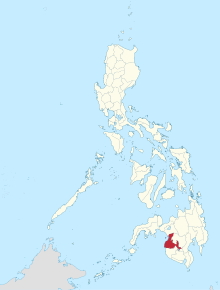
Back Maqindanao qətliamı Azerbaijani Massaker in Maguindanao 2009 German Matanza de Maguindánao Spanish Maguindanaon verilöyly Finnish Massacre de Maguindanao French Pembantaian Maguindanao ID Massacro di Maguindanao Italian მაგინდანაოს ხოცვა-ჟლეტა Georgian Pembunuhan beramai-ramai Maguindanao Malay Maguindanao-massakren NB
| Maguindanao massacre | |
|---|---|
 Map of the Philippines with Maguindanao highlighted | |
| Location | Sitio Masalay, Barangay Salman, Ampatuan, Maguindanao (now Maguindanao del Sur), Mindanao, Philippines |
| Coordinates | 6°48′34″N 124°26′22″E / 6.80944°N 124.43944°E |
| Date | November 23, 2009 approx. 10:00 a.m. – 3:00 p.m. (UTC +8) |
| Target | Esmael Mangudadatu's family members, supporters, journalists |
Attack type | Shooting |
| Weapons | Small arms |
| Deaths | 58[a] (Esmael Mangudadatu's family members and supporters, and 32 accompanying journalists)[2] |
| Perpetrators | |
No. of participants | 197 |
| Verdict | See Verdict section below |
The Maguindanao massacre, also known as the Ampatuan massacre, named after the town where mass graves of victims were found,[5] occurred on the morning of November 23, 2009, in the town of Ampatuan in then-undivided Maguindanao (which is now Maguindanao del Sur) province, on the island of Mindanao. The 58 victims were on their way to file a certificate of candidacy for Esmael Mangudadatu, vice mayor of Buluan, when they were kidnapped and later killed. Mangudadatu was challenging Datu Unsay mayor Andal Ampatuan Jr., son of the incumbent Maguindanao governor Andal Ampatuan Sr. and member of one of Mindanao's leading Muslim political clans,[6] in the forthcoming Maguindanao gubernatorial election,[7] part of the national elections in 2010. The people killed included Mangudadatu's wife, his two sisters, journalists, lawyers, aides, and motorists who were witnesses or were mistakenly identified as part of the convoy.
The Committee to Protect Journalists (CPJ) has called the Maguindanao massacre the single deadliest event for journalists in history.[8] At least 34 journalists are known to have died in the massacre.[9] Even before the Maguindanao massacre, the Committee to Protect Journalists had labeled the Philippines the second most dangerous country for journalists, second only to Iraq.[10]
- ^ "Andal Jr, several other Ampatuans convicted over Maguindanao massacre". GMA News. Archived from the original on December 19, 2019. Retrieved December 19, 2019.
- ^ Jimenez-Gutierrez, Jason (November 23, 2010). "Philippines mourns massacre victims". Philippine Daily Inquirer. Archived from the original on June 27, 2015. Retrieved November 23, 2010.
- ^ a b "Ampatuan brothers, several others found guilty in Maguindano massacre". ABS-CBN News. Archived from the original on December 19, 2019. Retrieved December 19, 2019.
- ^ Cite error: The named reference
zalds2was invoked but never defined (see the help page). - ^ Analyn Perez (November 25, 2009). "The Ampatuan Massacre: a map and timeline". GMA News. Archived from the original on February 15, 2015. Retrieved May 18, 2013.
- ^ "Behind the Philippines' Maguindanao Massacre". Time. November 27, 2009. Archived from the original on March 27, 2017. Retrieved November 20, 2013.
- ^ Jimenez-David, Rina (November 24, 2009). "Understanding the unbelievable". Philippine Daily Inquirer. Archived from the original on November 27, 2009. Retrieved November 24, 2009.
- ^ Papa, Alcuin (November 26, 2009). "Maguindanao massacre worst-ever for journalists". Philippine Daily Inquirer. Archived from the original on November 29, 2009. Retrieved September 30, 2010.
- ^ Cite error: The named reference
inquirer238100was invoked but never defined (see the help page). - ^ "Philippines Archives". Archived from the original on June 1, 2022. Retrieved June 3, 2022.
Cite error: There are <ref group=lower-alpha> tags or {{efn}} templates on this page, but the references will not show without a {{reflist|group=lower-alpha}} template or {{notelist}} template (see the help page).
© MMXXIII Rich X Search. We shall prevail. All rights reserved. Rich X Search